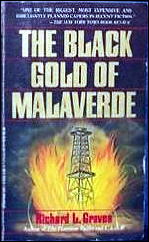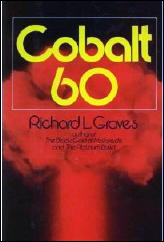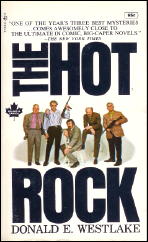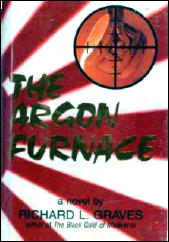Wed 23 Mar 2011
THE EXPLOSIVE NOVELS OF RICHARD L. GRAVES, by George Kelley.
Posted by Steve under Authors , Reviews[7] Comments
by George Kelley
Richard L. Graves is a consultant on weapons and pyrotechnic devices as a result of the US Army training him as a demolitions expert. And his five caper novels feature explosives as a touchstone for the major action.

Graves’ first novel, and his best, is The Black Gold of Malaverde (Stein & Day, hc, 1973; Bantam, pb, 1974). My thanks go to Bill Crider for calling this book and Graves’ work to my attention.
The Black Gold of Malaverde begins with a guerrilla takeover of the South American country of Malaverde led by a buffoon named Mercado. But behind Mercado and his peoples’ revolution is the shadowy figure of international financier DePrundis. The wealth of Malaverde is its black gold: oil.
The Malaverde oil industry has been controlled by Bradford Petroleum, but during the takeover D. J. Bradford, son of the American millionaire, is captured and later killed.
Bradford Senior, burning with grief and revenge, turns to an obscure organization known as The Bank to avenge his son. The Bank is an economic intelligence agency who sees DePrundis’s influence as a threat to the international monetary stability they protect.
The Bank allows Bradford to contact Hugo Wolfram, a demolitions expert now running a company specializing in stopping oil fires. Wolfram is the architect of the caper to ruin the entire country of Malaverde. He recruits a Japanese actor, two divers, a master seaman, and a pilot.
The plan is ingenious, realistic, and suspenseful. The result is a holocaust of devastating scope. The unique feature of the caper is the stipulation it look like a monstrous accident and Wolfram manages to fulfill that condition too, with a minimum loss of life. I strongly recommend The Black Gold of Malaverde.
Less successful is The Platinum Bullet (Stein & Day, hc, 1974; ppbk, 1985). DePrundis, who managed a narrow escape in The Black Gold of Malaverde, links up with the Russians in an attempt to corner the platinum market. Again, The Bank calls in Wolfram and his crew to neutralize this threat.
Wolfram and his people work a classic “platinum mine” con on DePrundis and the Russians. The caper is fun but lacks suspense. One problem is Wolfram has a crew of four specialists who aren’t challenged enough to develop suspense and characterization as a result of their actions. The result is an entertaining but superficial novel.

The scene shifts to the Mid-East in Cobalt 60 (Stein & Day, hc, 1975; ppbk, 1986). The Emir of an oil-rich country plots the assassination of many world leaders including most of the top levels of American political leadership: the President, Senators, and Representatives.
The Bank initially asks Wolfram and his people to look into the situation. Wolfram discovers the Emir is producing highly radioactive cobalt pens and paperclips. The idea is to plant these common, innocent-looking items near world leaders and let the deadly radiation silently kill them.
Cobalt 60 ends with a wild chase scene, but again there doesn’t seem to be enough for Wolram’s crew to do.
The last Wolfram book, Quicksilver (Stein & Day, hc, 1976; ppbk, 1981), is the silliest. Harry Descau, a devious international moneymaker, forms a partnership with the Cubans and a defected Russian physicist. Then, in their jungle base in Guatemala, they transmute mercury into gold using a nuclear reactor.
The Bank discovers Descau’s plan to disrupt the entire international gold market and calls in Wolfram and his team. Wolfram’s solution, naturally, is to destroy the base and its reactor. The method is extreme: amplify that region’s natural earthquakes into a big one that will cause a nearby lake to overflow, wiping out the entire operation. It works. But it all seems too easy, too glib, and too tacky.
I suppose this is a good place to talk about the formula of caper adventures. Graves’ earlier novels succeeded because they more nearly satisfied the conditions of the caper formula.

Basically, the caper is planned, executed, and then something goes wrong and the characters have to improvise. Lionel White, one of the masters of the caper novel, told me he develops his characters so their flaws cause the caper to fail.
Donald Westlake does the same thing in his caper spoofs like The Hot Rock and Bank Shot. In programs like Mission: Impossible, essentially a caper format, the unexpected equipment failure or some random factor forced the IM team to improvise; that failure of the plan provided suspense and a chance for the characters to come up with ingenious solutions to the problem, delighting the audience.
Whether the caper fails because of the flaws of the characters executing it, or if the caper succeeds after the characters come up with clever actions to overcome the problems, it is essential something go wrong with the caper.
A perfectly executed caper is boring.
Donald Westlake asserted that tenet while writing about Parker, his professional thief. The Parker series of capers, written by Westlake under his Richard Stark pseudonym, are variations of the theme: “We had the perfect caper — then something went wrong.”
Essentially, Graves’ later novels are perfect capers and they lack the excitement and suspense of The Black Gold of Malaverde.
Perhaps Graves realized this when he wrote his latest book, C.L.A.W. (Stein & Day, hc, 1976; ppbk, 1984). A secret group of terrorists plan to disrupt the Presidential Campaign and assassinate the country’s leadership. They rob an Army munitions base, stealing three missiles and eleven artillery shells.
Benton Dace, an American intelligence officer, and the obligatory beautiful KGB agent follow the clues that lead to a potential massacre at the Presidential inauguration. The action is fast-paced, the caper is realistic, and the quality is reminiscent of The Black Gold of Malaverde.

Editorial Comment: One additional novel by Richard L. Graves, published after this review was written, was The Argon Furnace (Scarborough House, hc, 1990). Publishers Weekly described the plot thusly:
PW also says the book is “relentlessly predictable” and yet the “action scenes are dynamic.”
March 23rd, 2011 at 6:46 pm
One big hole in the amount I know about crime and mystery fiction, which seems to be decreasing at a prodigious rate, as a percentage of what there is to know, consists of spy and caper novels from the 60s and 70s like these by Richard Graves.
I’d never heard of him, nor do I have any of his books. I don’t even suppose he was a big seller at the time, since the number of used copies of the five books that George wrote about goes down drastically as you go searching for them chronologically.
There are only 11 copies of C.L.A.W. on ABE for example, compared to 47 of BLACK GOLD, his first.
And George is 100% correct in pointing out that in caper novels, something has to go wrong.
The Joe Pike novel by Robert Crais I reviewed a while back had the same flaw as far as I was concerned. The hero was simply too perfect, essentially invulnerable.
March 23rd, 2011 at 9:09 pm
I suppose being a demolitions expert perfection is one of the survival skills.
I did not care for this one at all and never got past BLACK GOLD OF MALVERDE, which suffered both from a high silly factor and no sense of humor — which is a rarity in itself.
And while I don’t doubt Graves expertise in demolitions what he knew about the oil business and oil well fires seemed to have been culled from multiple viewings of HELLFIGHTERS and FLOWING GOLD.
From the description he wasn’t much better informed on the properties of radiation described in COBALT 60.
You have to grant most thrillers a certain ammount of ‘the Fleming effect,’ but at least when Fleming made up mumbo jumbo it sounded right — sort like the Amherst Villiers supercharger on Bond’s Bentley (Amherst Villiers was a friend of Flemings, not a car part).
The great thriller writers have a gift for doing just enough research and spacing it out in just the right amounts so that even readers who have expertise in the area they are writing about can sometimes be fooled. If Graves had experience in the oil business or with blowing out oil well fires it certainly didn’t show.
What Graves has done is an early appeal to what would become the basic Tom Clancy audience. Sadly for him there was no JANES for the oil buiness or fighting oil fires.
No tension, not much suspense, a bland hero, and inadequate or poorly presented research is not the model for a really succesful career writing thrillers.
March 23rd, 2011 at 9:52 pm
In Graves defense I might add that books and movies with an oil background are a pet peeve of mind. I still haven’t forgiven DALLAS for giving the impression there are oil wells in Dallas County. Unless they have found it in the last five years there is no and never has been any oil worth drilling for in Dallas (and incidentally South Fork was in Tarrant County).
And incidentally, despite every movie you have ever seen no one has deliberately allowed an oil well to blow in since the end of the 19th century. Some blow up, but they don’t blow in.
March 23rd, 2011 at 10:19 pm
Thanks for reprinting this long forgotten (at least by me) review. Today, Graves wouldn’t be published (unless it was a vanity publisher). I still think the caper genre is viable, but it has to be of the OCEAN’S ELEVEN (remake) variety.
March 23rd, 2011 at 11:17 pm
George
I was surprised Graves got published then. Maybe they were afraid not to, all things considered.
March 24th, 2011 at 7:22 am
Glad you reprinted this one, Steve, as George’s piece has long since gone out of my memory bank.
October 20th, 2012 at 5:06 pm
thanks so much for this information. I am presently reading The Black Gold of Malaverde; which prompted this search for me to locate other works of the author. He’s truly amazing with his dialogue.